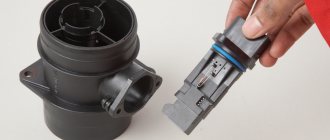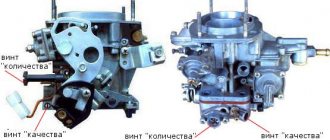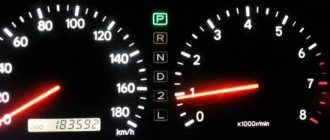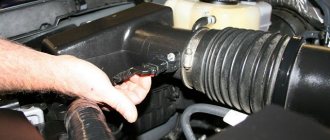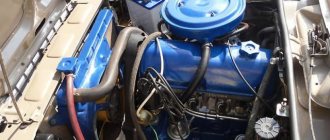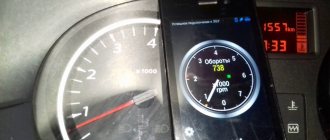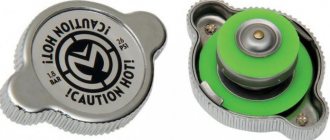Another question that worries many VAZ 2109 owners: why does the engine speed fluctuate at idle? There can be no single answer, as for many other questions. But you can give some recommendations and tips to find and fix these problems.
On carburetor VAZ 2109 models, in most cases the cause is either a malfunction of the carburetor and its incorrect adjustment, or an incorrectly set ignition (most likely later).
As for injection engines, there may be many more reasons, since the ECM system is quite capacious and complex. Let's look at some of the many:
- IAC malfunction. Idle speed regulator - it is this “sensor” that is responsible for the stable operation of the engine’s idle speed. And if the stability of operation is impaired, then there is a high probability that it is the IAC that is the cause of this disaster.
- Failure of the throttle position sensor is also not uncommon. By the way, floating speed can also easily be the cause.
- DMRV is faulty. To understand how much the mass air flow sensor influences floating speed, check out the video below, which clearly shows an example of a “broken” mass air flow sensor.
- Air leak in the power system. This is especially true for the injector inlet pipe, which runs from the air filter to the throttle assembly. If a loose clamp or a rupture of a hose or pipe is detected, this problem must be urgently corrected.
- Malfunction in the ignition system. There can actually be many reasons here, from spark plugs and wires to ignition coils. Even a banal large gap on the spark plugs can cause the speed to fluctuate.
- Failure or uneven operation of one of the injector nozzles. Injectors can become clogged from time to time because the fuel cleanliness is not ideal. And the cause of uneven fuel supply can be a clogged injector. Which entails floating revolutions, as a consequence.
On a VAZ 21103 car the revs fluctuate: what to do?
Many people underestimate the importance of sensors or idle air control.
But in fact, the speed stability depends on the correct operation of the IAC. It also prevents the car from stalling when the gearshift lever is in an intermediate position. In this material we will talk about the meaning, device, and signs of malfunction of this device. We’ll also tell you how you can easily replace the IAC with your own hands.
Appearance of the device
Injector. Causes of high idle speed.
On an injection engine, the controller controls the idle speed depending on the engine temperature. The actuator for this is the idle speed regulator, which is installed on the throttle assembly.
When the engine is cold, the speed is higher and decreases as it warms up. This is necessary so that the engine warms up faster and runs stably.
Reasons for increased turnover.
Idle speed regulator.
On VAZ cars this is a stepper motor that has two windings and four contacts in the connector. One winding is used for the rod to move out of the body, and the second for the rod to enter the body. A cone valve is installed on the rod to regulate the air supply through the channel in the throttle assembly.
When the engine is running, the rod may jam and the controller will not be able to control the idle speed. In order to check the regulator without special instruments, you need to remove it from the throttle assembly and test the windings with a multimeter. Next you need to determine whether the rod moves. To do this, you need to apply power to one of the regulator windings. This needs to be done as follows: connect two wires to the battery, and periodically changing the polarity, touch the two contacts on the regulator that correspond to one winding. In this case, the rod must either enter the body or extend out of it. If so, then the regulator is working.
In order to extend the life of the regulator, you need to lubricate its rod.
Throttle position sensor.
Just like the regulator, it is installed on the throttle assembly and has three contacts in the block. Two contacts power the third output signal. The sensor resistance changes depending on the throttle position, that is, in fact, this sensor is a variable resistor. You can check it by connecting the multimeter probes to two contacts, and smoothly opening the throttle to see how the resistance of the sensor changes. It should smoothly decrease without jumps when opening and increase when closing.
If the throttle cable is too tight, the idle speed will freeze.
The throttle assembly must be clean inside, otherwise the throttle valve will become stuck on deposits and the idle speed will also increase.
Engine temperature sensor.
This is a thermistor whose resistance changes depending on temperature. If it is not working properly, the idle speed will not be adjusted correctly. You can check it as follows. You need to compare the engine temperature with the sensor resistance and see in the table whether these parameters correspond to each other. Due to poor contact in the connector of this sensor, the speed may also fluctuate. When the engine is running, you need to move this connector and monitor the revolutions; if they change, then it’s the problem.
Source
Causes of the problem
When the engine is running normally, the car starts and warms up easily. The tachometer needle shows 2,000 rpm and as it warms up it drops to 900 rpm. This doesn't always happen. The engine is started, it begins to warm up, but it becomes noticeable that the VAZ’s revolutions begin to fluctuate. Moreover, absolutely nothing depends on the driver. The engine runs on its own.
The revolutions can fluctuate within very different limits. The minimum drop in rpm is close to 500, and the maximum reaches 1,500 rpm. Usually after 5 minutes the engine starts working stably and the problem disappears. However, she periodically reminds herself. You need to fight floating speeds. First you need to establish the reason why the VAZ 2110 is not gaining momentum. Possible reasons.
To check the solenoid valve, you need to supply power to its contact with the ignition on. After touching, there should be a strong click. If there is no click, you need to connect the contact directly to the “plus” of the battery. If there is no click again, it means the valve has failed and requires replacement. It happens that the click is clearly audible, but the speed continues to fluctuate.
Most likely the valve jet is clogged. The cause of floating speed may be a dirty air filter. In addition, the ignition system and the lack of air leaks also affect the speed. And if the VAZ 2110 is an injector? Modern cars that have an injector instead of a carburetor, where the fuel supply is regulated by a special sensor, the appearance of floating speed is most often associated with the failure of one of the sensors.
What happens? The electronic control unit tries to read information and does not receive it. Why is this happening? The electronic control must constantly receive information about the operation of the engine, but this does not happen, resulting in unstable, floating speed.
What if the electronic control unit is broken? Quite often, it is this “think tank” that becomes the main reason for the drop in speed. When one of the sensors that regulate the normal operation of the engine fails, or foreign air enters, the system does not receive an accurate command from the on-board computer. This is where floating speeds appear.
It is impossible to find the problem and fix it on your own. An accurate diagnosis is needed, which is performed at a service center on a special stand.
Tips for motorists
As you know, the VAZ-2110 passenger car was produced with two types of engines: carburetor and injection. But, regardless of which engine was in the “ten”, a malfunction in the form of floating revolutions occurred on both types of engines, only the reasons for its occurrence were naturally different.
The main culprit of floating speed on VAZ-2110 carburetor engines was a pre-start device , with which the air damper opened as the liquid in the cooling system warmed up. The pre-launch device is very sensitive to unqualified intervention. As soon as the adjustments were slightly knocked down, even bigger problems immediately began with floating idle speeds, which arose especially clearly when starting the engine. When disassembling the pre-launch device, in no case should the bimetallic spring be touched, as this led to a change in its calibration, as a result of which it could not open the air damper according to the technical conditions.
On injection engines, the accuracy of the composition of the combustible mixture formed in the cylinders on the intake stroke is controlled by the ECM controller (electronic engine control system). Therefore, the crankshaft speed will directly depend on the accuracy of the sensors that supply information to the ECM, which, having processed it, issues commands for the opening time of the electromagnetic injectors, which allows the required amount of gasoline to be supplied to the cylinders depending on the engine operating mode.
Lost idle speed on injection engine, reasons
A list of the main, most common reasons for the appearance of unstable idle speed or their complete disappearance on injection engines (2111) of VAZ 21083, 21093, 21099 cars. All malfunctions are grouped by engine systems: ignition system, power system, control system (ECM), engine engine.
Most of them are easily determined using diagnostic equipment, but faults can be found without it. Before identifying a malfunction, it is necessary to carry out a visual inspection of the engine compartment (elements of the ignition system, sensors, tubes, hoses), check the tightness of the contacts in the connecting blocks, the tips of high-voltage wires in the ignition coil and spark plugs.
Causes of unstable idling of an injection engine related to the ignition system
— Spark plugs are faulty
Faulty spark plugs: flooded after an unsuccessful start, the insulator is “broken,” the gap between the electrodes does not correspond to the norm (0.9 – 1.1 mm), the spark plugs do not match the engine’s heat rating. External signs: unstable idling, uneven exhaust from the muffler (periodic or frequent misfires). It is necessary to blow out the spark plugs: press the gas pedal all the way down and crank the engine with the starter for several seconds (the so-called purge mode). Having turned them out, evaluate the condition of the contacts, the presence and color of carbon deposits, and check the gap with a round feeler gauge. Non-working spark plugs are often clogged with carbon deposits or wet. But in some cases it is impossible to determine their malfunction visually, so the easiest way is to install a new kit and check the engine idling again.
— High-voltage wires are “broken”
External signs are similar to candlesticks. You can check the serviceability of the wires with a tester in ohmmeter mode. You can start the engine in the dark and observe the glow on the “broken” wires. In addition, it is necessary to visually verify the integrity of the wires and their tips, the absence of dirt and cracks on them.
Measuring the resistance of high-voltage wires
— The ignition coil (module) is faulty
First, we inspect the coil: check for cracks and damage. Then we check it with a tester in ohmmeter mode (See “Checking the ignition module”). We replace the one that does not pass the test with a serviceable one.
Malfunctions related to the engine control system (ECM)
— Idle speed regulator (sensor) (IAC) is faulty
The rod of a faulty regulator may not timely close the air supply channel necessary for engine operation at idle under the throttle valve. Signs of a faulty regulator, in addition to unstable idling: starting the engine by pressing the gas pedal, jerks and drops in speed when changing gears and coasting, “floating” speed, idling sometimes, sometimes not, drop in speed when powerful electrical consumers are turned on. At the same time, in other modes with the gas pedal pressed, the engine can operate normally without failures, jerking or jerking. The sensor can be checked with a tester or replaced with a known good one (by adjusting the protrusion of its needle).
— Throttle position sensor (TPS) is faulty
A faulty TPS may provide the control unit with incorrect information about the throttle position. As a result, at idle speed the engine speed may increase greatly and be reluctant to decrease to normal or not decrease at all. The TPS can be checked with a tester or replaced with a working one.
Device role
On injection engines that are installed on the VAZ 2110, the XX regulator serves to control the stable operation of the power unit. It is unlikely that you will be pleasantly surprised by a situation in which the idle speed starts to fluctuate, and every now and then the car will stall.
Some people do not know about another very important role of the idle speed sensor - warming up the power unit in case of low air temperature.
It is generally accepted that if there is an injector, there is no need to warm up the engine. The opinion is wrong. Do not overstress the engine, but first let it run for a while without increased speed. This will have a positive effect on the reliability and service life of the motor. .
Location
Externally, the IAC looks quite simple. It looks like a small electric motor. Its design includes three parts:
And the desired regulator is located near the mechanism that is responsible for changing the position of the throttle valve. There is no complex fastening system. To dismantle you just need to remove the mounting bolts.
How does he work
The function of the IAC is to regulate the amount of fuel supplied. He may indicate the need to increase or decrease the quantity. An important nuance is that the sensor performs its functions directly when the idle speed is turned on.
The actual action of increasing or decreasing occurs due to the extension or retraction of the needle at the end of the rod. The needle is responsible for closing or opening the special channel to the required extent.
Learning to distinguish a fake from an original
Today, many people complain about the abundance of counterfeit products on the auto parts market.
If we talk specifically about the XX regulator for the VAZ 2110, then there are several key signs by which a fake can be distinguished from the original. Be guided by these data so as not to accidentally install a device of dubious quality and origin on your car.
Clogging in a carburetor engine is the main cause of the problem.
If dirt is found in the carburetor engine, then the likelihood of malfunctions is high:
- Blockage in the area of the fuel and air jet of the cold running system. The failure can be eliminated by cleaning the fuel and air jets. To solve this problem, the carburetor cover is dismantled.
- Solex air valve is dirty. If the level of contamination is high, then it is appropriate to replace this element with a new one. The unstable motion will disappear, the swimming will disappear.
- There is a blockage in the fuel system filter. When a large amount of contaminants accumulates, an effect such as floating idle speed on a VAZ 2109 often occurs.
Speed floats with a faulty mass air flow sensor on an injection engine
Watch carefully and perhaps in this video you will find the reason why your engine speed is fluctuating.
As you can see, from the video review it is clearly visible that the symptoms can be quite sad and in addition to the floating idle, there are many negative consequences from such a malfunction.
If you have anything to add to this article, write in the comments and discuss it together!
This problem is often talked about a lot, both on forums and in print publications for car enthusiasts. Idling speed of the VAZ 2109 (carburetor) is a whole story. And, unfortunately, not always with a good ending.
The speed of the VAZ 2109 injector floats! Help!
Hello dear forum users. A hackneyed topic, but I will write everything down in great detail. In general, the following problem has been observed for about 4 winter months. The revs fluctuate at xx, or when you drop from speed to neutral. If the car may not stall, then it itself restores its speed if it stalls while driving, i.e. when I'm driving towards a traffic light, for example, I either immediately start it with the key or the gas pedal. The following work was done: DPKV, IAC (Omega) sensors were replaced, oil pressure sensor, mass air flow sensor (Bosch original); valves adjusted; The throttle valve and the crankcase gas mesh were cleaned. The problem remains the same as it was before all this. The other day we measured the fuel pressure and it showed 2.0, which is not enough. I changed 2 fuel pressure regulators, the readings did not change (it is quite possible that the sensors are defective). It doesn’t consume oil, the power remains at the same level as always, it doesn’t throttle, the engine runs smoothly (until the revs start to fluctuate). It costs BC Multitronics, the value of the mass air flow sensor is about 11.5 - 12.6, which is also a lot. Sometimes it goes down to 10.5. After replacing the mass air flow sensor, the speed began to fluctuate less, but still sometimes they play pranks. The trend cannot be tracked; the problem arises whenever it wants.
p.s. Now I’m planning to buy a fuel pressure gauge and properly examine the fuel system. Change the fuel filter, clean the fuel pump strainer again. Find a good fuel pressure regulator.
Solution
Re-gasping can solve the problem in cases where, when the engine is running, the speed in the car also drops. In any case, if the problem is not very serious. But changing the gas is only a temporary solution that saves the driver only for a short period of time. After this operation, you cannot completely forget about the problem. And if possible, try to correct it immediately.
In terms of speed, car owners often experience inconvenience when the cold season sets in. The corrugation for hot air intake from the engine to the carburetor is often missing in the car, which becomes the main cause of concern. The thermostat and corrugation must also be attached to a bracket, which our drivers often simply don’t have.
In fact, each problem must be analyzed individually, depending on the conditions in which it arose. But in this article we tried to sort out the questions that arise most often among car owners. And the methods described above have been tested in practice more than once; they really help to cope with technology when an unforeseen situation arises. But this does not mean that you can forget about car services and carry out all repair work alone. Sometimes it’s still better to turn to specialists. After all, only they can provide a thorough diagnosis of any car. Perhaps this will help identify other problems.
VAZ 21099 injector: why does the idle speed fluctuate?
With the advent of electronic sensors in the design of a modern engine that control the operation of its systems and mechanisms, it has become possible to achieve fuel efficiency of the engine and reduce the concentration of harmful gases in the exhaust. At the same time, malfunctions occurred in the operation of special sensors and control units.
One of the most common malfunctions of Lada gasoline models is when the VAZ 21099 injector floats at idle speed. Moreover, such a problem can arise both when the engine is cold or when the engine is warm, when the car is stopped at a traffic light.
Procedure: from simple to complex
The simplest solution is to sell the car. Maybe this is the best decision. When your car has a high mileage and service life, and you are not a professional auto mechanic, then there is no point in undertaking repairs. If you are not very strapped for money, if numerous “unreasonable” breakdowns occur, perhaps the best solution is to exchange the VAZ 2109 for a simple used foreign car or a new Lada.
But if you decide to tinker with your Samara and adjust the idle speed yourself, start with simple things. Inspect the electrical wiring, inspect the contacts, touch the connector pads. The causes of floating faults often lie in the vehicle's electrical wiring. It gets hot and dry - there is contact, gets wet and cools - there is no contact.
If, when moving the wires under the hood, a malfunction appears and disappears, start ringing the wires one by one. Particularly vulnerable in the “nines” is the harness that leads to the fuse box. It is located next to the drain coming from the windshield, and during precipitation it gets wet more intensely than others.
Among other simple things that can cause the 9's engine speed to fluctuate at idle is a clogged air filter. This applies to both carburetor and injection versions of the power plant. It's easy to check.
Remove the air filter from the preheated engine, leaving the carburetor inlet pipe freely open. Start the engine. If the speed stabilizes, change the air filter. If not, install the filter back and move on to further research.
Engine design with injector
In order to understand the reasons for the occurrence of floating speed in the VAZ 21099 gasoline engine, you should refer to the design of the engine. The car is equipped with a 1.5-liter gasoline engine with distributed fuel injection. This means that gasoline is delivered separately to each cylinder through the injectors. This design not only made it possible at one time to bring this engine into the category of economical ones, but also to significantly reduce the content of harmful gases in the exhaust.
What is the reason for floating revolutions
Car owners often continue to operate their vehicle even if the engine is unstable while driving. However, such a malfunction can have a number of negative consequences. Firstly, floating speeds can easily lead to a traffic accident when, when coasting or changing gears, the engine stops working and the steering wheel jams. In addition, the driver must be constantly distracted in order to stabilize the speed by stepping on the gas or simply not allowing the engine to stall by keeping his foot on the gas. Secondly, fuel consumption increases significantly, and all engine operation systems operate in variable mode, which creates additional load on them. The malfunction is easily diagnosed, its elimination does not require significant investment of time and money.
Check the spark plugs first
If the coordinated operation of individual components of the power and ignition system is disrupted, various malfunctions occur that lead to engine failures. One of the first signs of a problem is high engine speeds if the injector stalls while driving. The most typical manifestation of a possible malfunction is a situation where the idle speed fluctuates. The speed can change from 500 to 2500-3000 per minute with an oscillation interval of about 1 second. In this case, the number of revolutions is periodically equalized. If the amplitude is larger, the engine will most likely stall.
Situations arise when the control unit receives incorrect information, which is why the electronics cannot make a timely decision about the command being given. If an excess amount of air enters, while the engine temperature is sufficient for normal operation, and the throttle is open in the desired mode, the control unit may not cope with the problem. When engine speeds fluctuate or are simply high, one of the possible reasons may be improper operation of the forced speed increase device. This will be the culprit for the intake of too much air.
A faulty idle speed sensor may also be responsible for floating rpm. This device ensures stable engine operation at any speed. If the sensor does not transmit the correct signal, the volume of air supplied to the cylinder will differ from the required one. In this regard, floating speed is possible not only after starting the engine, but also after it warms up.
Let's list them.
- The most basic is a malfunction or failure of the mass air flow sensor.
- No less common is the breakdown of the idle air control valve.
- A crankshaft position sensor providing incorrect information to the control unit can also be the root cause of a high or floating idle.
- The throttle position sensor may also be to blame.
- It happens that for some reason the gas pedal does not return all the way back. Moreover, this happens both because of a banal malfunction of the cable, and because of something completely ridiculous - for example, after washing the car, they covered the driver’s mat in such a way that the tip of the mat began to touch the pedal.
- The air filter is very clogged. Because of this, the combustion mixture is too rich in gasoline, again resulting in high idle speeds.
- The cable came off the throttle valve.
- Engine temperature sensor faulty. It gives the car’s “brains” incorrect values, which increase the crankshaft speed, thinking that the engine is cold.
As you can see, we have before us a whole forest of very different reasons why high revs appear! Next, we will take a closer look at the most typical, plus the most common problems associated with the problem described. At the same time, we’ll figure out how to eliminate them with our own hands.
Ways to eliminate the “sore”
If such a problem occurs, you need to look for which node is to blame analytically, checking all the specified sensors
First, let's consider the following option for correcting the problem situation. Let's assume that a VAZ 2110 has high revs. An examination of the suspected components for faulty components showed that the throttle position sensor has traces of rust. It is located directly above the throttle valve. Measurements with a voltmeter showed that when the engine is idling, the voltage on it remains high - which means it does not close the damper.
How to fix the problem? For this we only need a screwdriver. Let's begin the procedure.
- By disconnecting the terminal block and also unscrewing two screws, we dismantle the assembly. We notice that traces of rust inside interfere with the movement of the wheel that regulates the position of the damper.
- We fill the insides of the defective device with a penetrating anti-rust aerosol.
- Use a development screwdriver to turn the wheel.
- We reassemble in reverse order.
Check to see if the engine idle speed is now high. The problem should go away.
Now let's look at another case. Let's say we have high idle speed in a VAZ 2114. This is what we do when faced with this situation.
When clarifying the circumstances of the problem under investigation, we always initially check the operation of the idle speed sensor. This device consists of a needle built inside an electromagnetic coil. The needle either moves inside the coil, moving away from the hole in the throttle pipe, or moves out, closing this hole, thereby stopping the supply of air for combustion of the mixture.
This element is located at the throttle valve, opposite the gas pedal cable. To diagnose it, we pull out the terminal block from it, start the car, after which we see that we still have high engine speeds that have not changed at idle. Then we remove this defective unit, then clean it or replace it. For work we take:
- screwdriver;
- toothbrush;
- petrol.
